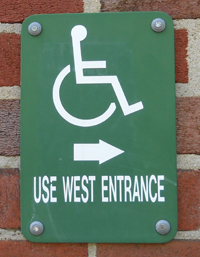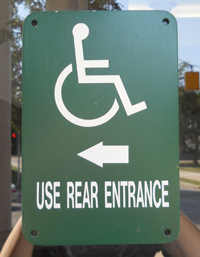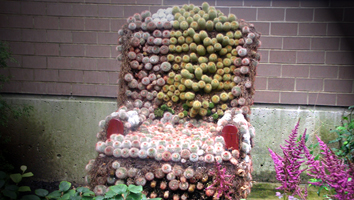You've arrived.
On the previous page, you may have found it confusing to be confronted with two choices that created a binary between “entering” our webtext and gaining “access” to it. Just to end the suspense, either button would have brought you here. We are combining the traditional entrance to an academic text, the abstract, with a statement on access, in an attempt to foreground the issue of access, rather than presenting it as an alternative entrance, like the loading-dock ramp located at the rear of a building.


Yes, these signs come from the same building.
Access statements on webtexts are often hidden from view, placed in a footer or off-site disclaimer (or just left off altogether). Such choices speak to the subjugation of accessibility as a rhetorical framework. Alternative entrances, disclaimers—by their very nature, these create a special population of people, whom we then identify as disabled.
Abstract
Our webtext is an exploration of the ways in which multimodal composition would benefit from a disability studies perspective. Disability studies allows us to regard the ways in which multimodal composing—and its investment in all sensorial possibilities "all the time" (Dolmage, 2011, n.p.)—normalizes and has been normalized by our understanding of the rhetorical triangle. Disabled individuals are among our colleagues and our students. Why is it that we so rarely design with them (us) in mind?
Traversing public and private spaces inevitably means finding a way to access those spaces. This simple fact is thrown into relief for those who experience barriers to access, and often unnoticed by those whose bodies, minds, abilities, and resources allow them to occupy the role of default user. Multimodality has been discussed at length as a means to enhance access to the public and private spaces through which we and our writing move. However, we argue that multimodality as it is commonly used implies an ableist understanding of the human composer. Our webtext seeks to redress this problem.
Access statement
 However, we also wish to include in our access statement an acknowledgment: Universal design is a process, a means rather than an end. There’s no such thing as a universally designed text. There’s no such thing as a text that meets everyone’s needs. That our webtext falls short is inevitable.
However, we also wish to include in our access statement an acknowledgment: Universal design is a process, a means rather than an end. There’s no such thing as a universally designed text. There’s no such thing as a text that meets everyone’s needs. That our webtext falls short is inevitable.
But to say that no text will be universally accessible is not a justification for failing to consider what audiences are invited into and imagined as part of a text. It matters who reads, it matters who engages, and it matters who is conceptualized as a reader. For example, we recognize that many readers of this webtext may not be familiar with the disability-studies concepts invoked here. To enable a wider range of readers, we've included a glossary that offers fuller context for important terms such as ableism and normate.
We offer the above disclaimer on inevitability as a way to open what is, we feel, a more productive discussion on what it means to center disability and disabled people, to work toward inclusion and activism and advocacy, toward universal design.
Since we first began this project, we have designed our webtext to be as accessible as possible for all users. If you have any difficulty accessing content, please let us know. We would be more than happy to send material in an alternative format. We can be reached at the following email addresses:
- M. Remi Yergeau, myergeau@umich.edu
- Elizabeth Brewer, brewer.169@osu.edu
- Stephanie Kerschbaum, kersch@udel.edu
- Sushil K. Oswal, oswal@u.washington.edu
- Margaret Price, price.spelman@gmail.com
- Cynthia L. Selfe, selfe.2@osu.edu
- Michael J. Salvo, salvo@purdue.edu
- Franny Howes, franny.howes@gmail.com


